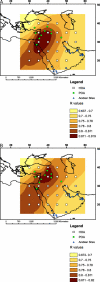Tracing the origin and spread of agriculture in Europe
- PMID: 16292981
- PMCID: PMC1287502
- DOI: 10.1371/journal.pbio.0030410
Tracing the origin and spread of agriculture in Europe
Abstract
The origins of early farming and its spread to Europe have been the subject of major interest for some time. The main controversy today is over the nature of the Neolithic transition in Europe: the extent to which the spread was, for the most part, indigenous and animated by imitation (cultural diffusion) or else was driven by an influx of dispersing populations (demic diffusion). We analyze the spatiotemporal dynamics of the transition using radiocarbon dates from 735 early Neolithic sites in Europe, the Near East, and Anatolia. We compute great-circle and shortest-path distances from each site to 35 possible agricultural centers of origin--ten are based on early sites in the Middle East and 25 are hypothetical locations set at 5 degrees latitude/longitude intervals. We perform a linear fit of distance versus age (and vice versa) for each center. For certain centers, high correlation coefficients (R > 0.8) are obtained. This implies that a steady rate or speed is a good overall approximation for this historical development. The average rate of the Neolithic spread over Europe is 0.6-1.3 km/y (95% confidence interval). This is consistent with the prediction of demic diffusion (0.6-1.1 km/y). An interpolative map of correlation coefficients, obtained by using shortest-path distances, shows that the origins of agriculture were most likely to have occurred in the northern Levantine/Mesopotamian area.
Figures



References
-
- Childe VG. What happened in history. Harmondsworth (UK): Penguin Books; 1942. 303 pp.
-
- Childe VG. The dawn of European civilisation. London: Routledge and Kegan Paul; 1968. 368 pp.
-
- Clark JGD. Radiocarbon dating and the spread of farming economy. Antiquity. 1965;39:45–48.
-
- Clark JGD. Radiocarbon dating and the expansion of farming culture from the Near East over Europe. Proc Prehist Soc. 1965;31:58–73.
-
- Ammerman AJ, Cavalli-Sforza LL. Measuring the rate of spread of early farming in Europe. Man NS. 1971;6:674–688.
Publication types
MeSH terms
LinkOut - more resources
Full Text Sources

